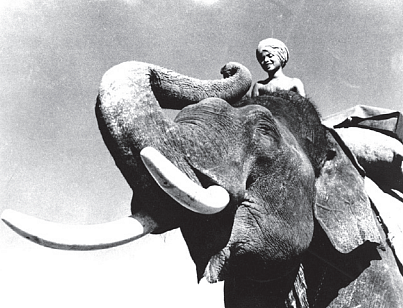India’s first international film star: The forgotten story of Sabu, the star
For decades now, India’s prime actors have been making a bid for global visibility– in roles, major or minor- in process amassing reams of publicity and flashbulb attention from paparazzi back at home

For decades now, India’s prime actors have been making a bid for global visibility – in roles, major or minor -- in the process amassing reams of publicity and flashbulb attention from the paparazzi back at home.
Of our actors, the late Irrfan Khan and Om Puri had scored the highest number of appearances in prominent roles globally. In fact, Om Puri was the first Indian actor to be awarded an OBE (Order of the British Empire) in 2005.
However, one actor, perhaps India’s only definitive international star, appears to be an unknown factor, especially to the ‘now’ generation. Some cineastes interested in the history of cinema of our pre-independence era do remember his unusual real-life story. Here was the quintessential Indian ‘native’ whose career in the West spanned almost 20 films, a majority of them in lead roles.
That was Sabu Dastagir, born circa 1924, in a small jungle-encircled town close to Mysore. Some accounts name him as Selar Sabu Shaikh, others as Sabu Francis. But what’s in a name? He just came to be known as Sabu. Incidentally, his 58th death anniversary was on December 3 this year.
It would seem that Sabu’s story of an unlettered Indian who found himself in swishy Hollywood circles, inspired Blake Edwards’ laugh-riot The Party (1968) – in which Peter Sellers portrayed a swarthy gatecrasher into a charmed but pretentious world of showbiz. Fortuitously, though, Sabu didn’t ever have to solicit an invitation to enter the exclusive enclaves. Indeed, his discovery and mentorship by the legendary documentary filmmaker Robert Flaherty are the stuff that dreams are made of.

Orphaned at the age of nine, Sabu served as a mahout or elephant driver – like his father had-- at the palace of the Maharaja of Mysore. Flaherty who had an eye for scouting talent, whether he was shooting Nanook of the North in the Canadian Arctic or Moana in the Samoan islands, instantly cast Sabu as Toomai, the eponymous Elephant Boy (1937), a character from Rudyard Kipling’s Jungle Book.
Next, the puckish 12-year-old boy was whisked off to London for a six-week-long spell of shooting at the studios. The boy never returned home, spending the best years of his life travelling beween the U.S. and the UK, signing up projects under the supervision of his elder brother. Flaherty was halfway through completing Elephant Boy, when he quit the project, over creative differences with the producers.
Enter Alexander Korda, who was so delighted with the spritely Sabu, that he also showcased him in The Drum (1938). Next came the cult swashbuckling classic The Thief of Baghdad (1940). Korda was one of the six directors who had bunged the milestone Arabian fantasy together, lauded particularly for its use of splashy colour and imaginative set décor.
Sabu was now established as an exotic fantasy figure – agile and puckish at the height of 5’7’’, perfect for films catering to children and teenagers. Aware of the popularity of the ‘jungle boy’ from India, Korda assigned him the part of Mowgli in The Jungle Book, earning Sabu the distinction of breathing life into two of Kipling’s most-lovable characters.
According to chronicled reports, on a high, Sabu became an American citizen in 1944, and served as a gunner in the US Air force towards the final stretch of World War II.
However, Hollywood had moved on to love stories and screwball comedies in the war’s aftermath. Sabu’s career lost steam, but not without a prominent supporting part opposite the fragile beauty Jean Simmons in yet another cult classic Black Narcissus (1947), helmed by Britain’s master entertainers Michael Powell and Emeric Pressburger. Inevitably, though, the Asian wonder boy’s market equity was to decline as he grew older. Walt Disney’s A Tiger Walks (1963) was his last but bland end to a believe-it-or-not career.
Exotica has a short shelf life, and India’s first international star passed away in California, following a heart attack, at the age of 39. A bittersweet end to a fantasy-kissed career. Three years after his passing away, he was inducted into the Hollywood Walk of Fame.
His actress wife Marilyn Cooper, the lore goes, had stood by Sabu when he was confronted with a paternity suit. Charged with siring a daughter, he was exonerated with an overwhelming no-guilty judgment. Long after his premature death, Marilyn’s and Sabu’s son Paul formed a rock band called Sabu, while their daughter Jasmine became an animal trainer.
Mini-biographies and Internet sites do trace Sabu’s unusual rise to and descent from stardom. Undoubtedly, his life story would be ideal material for a biopic, but it would entail an enormous budget with its locations shifting from Mysore and Britain to America.
It’s an unlikely project perhaps, but what’s the harm in dreaming? After all, Sabu did become India’s first star of international cinema. His is an uncanny eventful life of an elephant boy who rode on elephant-sized movies.
(This article first published in National Herald on Sunday.)
Follow us on: Facebook, Twitter, Google News, Instagram
Join our official telegram channel (@nationalherald) and stay updated with the latest headlines